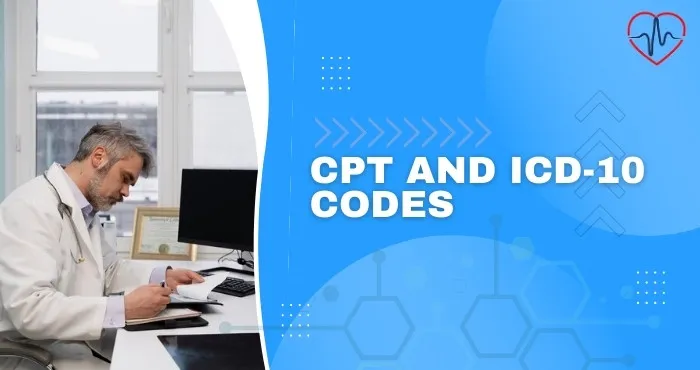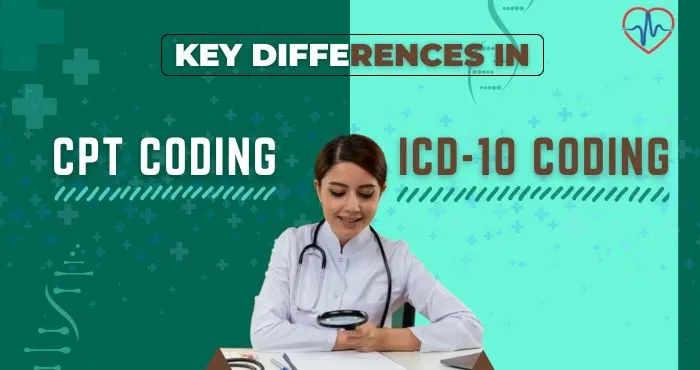Every healthcare practice strives for stability and profitability. However, it demands more than just medical expertise. The complexities are on the rise in the healthcare world with every new advancement in the industry.
The role of flawless coding and billing is undeniable for smooth billing, timely reimbursement, and keeping up with regulatory compliance. For every healthcare facility, mastering CPT & ICD codes is an essential skill.
In this blog, we are going to dive into the intricate world of ICD 10 and CPT codes and their relevance in the medical billing world. This information will serve as a detailed guide to understanding the differences, importance, and effective application of codes in your daily practice.
We are going to explore the distinct roles of every code set that will help you with accurate code selection and make you a master to optimize your healthcare practice.

What are CPT and ICD-10 Codes?
As we get into the diverse world of ICD & CPT codes, the very first layer is to understand what these ambiguous alpha-numeric words - CPT and ICD-10 codes, actually refer to.
In layman's terms, you can see them as the secret language in healthcare. They are basically conveying all the important information about all the services delivered and the reasons behind them.
CPT (Current Procedural Terminology) Codes
CPT codes serve as the foundation of medical billing. They focus on the “what” part during the patient encounter. CPT codes provide an outline of the various techniques used. It includes everything from manual therapies to the use of specialized equipment. You can consider them as the entries on your physical therapy bill. Each code represents a distinct service performed during your session.
These five-digit codes are developed and regularly updated by the American Medical Association (AMA). They basically provide a description of all the medical services provided. They are recognized and accepted by insurance providers, Medicare, and Medicaid. They are useful to prevent any chances of fraud within the medical billing world.
These codes give standardized language for describing medical procedures and services. This ensures an accurate compensation for healthcare providers.
CPT codes are classified into three categories: Category I, Category II, and Category III. Every category has its own purpose. For example - reporting services, measuring performance, and new technologies.
Apart from ensuring accurate and timely reimbursements, these codes also serve as an important data point for healthcare professionals and payers. They assist in keeping up with the healthcare trends and proper utilization of services. This information can assist in making better decisions for formulating healthcare policies.
Therefore, it is vital for all healthcare practitioners to understand CPT codes to safely navigate medical billing.
ICD-10 (International Classification of Diseases, 10th Revision) codes
ICD-10 is a universal standard that helps to collect, organize, and categorize information related to deaths and diseases. These codes help healthcare information to be easily stored, retrieved, and analyzed for accurate decision-making.
The guidelines of ICD-10-CM are approved by cooperating parties. The parties consist of the American Hospital Association, the American Health Information Management Association, and CMS.
ICD-10 gives a bigger picture and focuses on the "why" of the intervention by a medical professional. They concentrate on the primary diagnosis and get into the patient’s overall medical context. They explain the medical conditions that drive the need and justify the services rendered.
When you understand the world of ICD & CPT codes, you will be able to create a strong claim for insurance companies and ensure clear communication within the healthcare landscape.
When Are These Codes Updated?
CPT codes are updated annually to ensure advancements in the healthcare world. ICD-10 codes are revised every 10-15 years to maintain consistency and enhance medical accuracy. As a medical practitioner or a healthcare practice, it is important to stay current with these updates. It ensures smooth operations, accurate billing, and right patient care.

Key Differences in CPT & ICD-10 Coding
One of the major reasons behind errors in the medical billing process is the unclear understanding of the codes. ICD & CPT might seem interchangeable, it is important to understand their unique roles and know the major differences.
Based on Focus
CPT Codes
When we see the CPT codes, they represent specific procedures or services that are given during the patient encounter. It can be anything from doing manual therapy to using any special equipment. Every procedure has a CPT code attached to it that describes its essence. For example – CPT – 93842 is for electrical stimulation, various channels, 4 or more areas. On the other hand, 97124 defines Therapeutic exercise, one area, individual".
This is the level of specificity which assists clear communication with insurance providers.
ICD Codes
A much bigger picture is represented by ICD codes. They explain the story behind the invoice and reveal the condition of a patient and why the intervention was done by the practitioner. Whether it’s a rotator cuff tear (code S47.61) or an ankle injury (code S83.3), the ICD-10 codes will capture the primary diagnosis.
When you link the diagnosis to the various processes initiated, it becomes a strong narrative for the insurance providers to justify the services provided and operating that revenue cycle at an optimum level.
Based on Specificity
CPT Codes
In the case of CPT codes, they offer multiple options for similar procedures. This is to ensure precise representation. For instance, for manual therapy there are multiple CPT codes. They are distinguished by the body region: code 93860 for cervical spine mobilization and code 93862 for lumbar spine mobilization.
It is important to choose the most accurate CPT code out of all to make sure that it is able to reflect the complexity and depth of the illness.
ICD Codes
A more generic approach is taken in the case of ICD codes. A single ICD code may be used for "cervical pain" (M54.2) with subcategories for more precision. Choosing the right ICD code with similar sub-categories helps to give a complete picture of the patient’s problem.
Based on Number of Codes
CPT Codes
The CPT codes are a concise list of carefully curated entries. As of September 2023, the Current Procedural Terminology (CPT) code set includes a total of 11,163 codes. This number of CPT codes changes every year. This is due to the addition of new codes and the removal of outdated ones.
ICD Codes
You can imagine the ICD-10 code as a set of sprawling encyclopedia full of information. The number of International Classification of Diseases (ICD) codes is different. It depends on the type of ICD and the version that is used by the practitioner.
There are over 70,000 ICD-10-PCS procedure codes. The update to the ICD-10 code set in 2024 added 395 new codes, deleted 25 codes, and updated 22 existing ones.
Tips to Guide Your Code Selection
Careful consideration is needed to select the appropriate and accurate codes for the medical procedure performed.
Hereunder are the tips to guide you in your code selection:
Match Every Process to Code:
Make sure you identify the procedures and techniques that you perform during every session. The second step that you must ensure is that you are getting the corresponding CPT code that will best describe your procedure.
Be Specific:
Make sure that you choose the most specific CPT and ICD code that is available for the particular procedure. The code must accurately represent the complex nature and specifics of the service rendered.
Remember the Modifiers:
Along with the codes, it is important that you use the appropriate modifiers to show all the additional information about your service. For example – the treatment area and the duration.
Create a link between the Diagnosis and Procedure:
Properly review that the ICD-10 code you choose reflects the primary diagnosis of a patient. Along with that the CPT code selection must be justified.
Impact of Accurate Coding on Your Healthcare Practice
Proper ICD-10 Coding and CPT Codes are not just a formality. It is truly a backbone for an efficient revenue cycle and financial stability.
Proper Coding Ensures:
Better & Timely Reimbursements
When you code correctly, you are more likely to be reimbursed on time by insurance companies. This leads to the proper flow of revenue in your healthcare practice.
Improved Compliance
Keeping up with the ever-evolving coding guidelines reduces the risk of audits in the organization. It also saves the healthcare practice from potential penalties.
Proper Equilibrium within the healthcare practice
When you follow the efficient coding practice, it saves your time and resources and allows you to focus on giving quality patient care.
Conclusion: Gain Coding Confidence with Unify Healthcare Services
Fighting the complex world of codes doesn’t have to be a solo mission anymore. With the knowledge, expertise, and the best tools for medical billing and coding, you don't have to worry about your timely reimbursements. It is time to claim your place among the top healthcare practices and give more time to what truly matters – your patients.
























